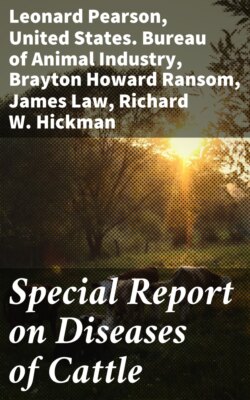Читать книгу Special Report on Diseases of Cattle - Lowe - Страница 90
На сайте Литреса книга снята с продажи.
LOCO.
ОглавлениеThe loco plants have caused especially heavy losses of cattle, horses, and sheep. They grow in the semiarid regions of the West and sometimes in great luxuriance. The best known are the "blue loco," the "woolly loco" or "purple loco," and the "white loco" or "rattle-weed." The blue loco is common in parts of New Mexico, Arizona, and Utah. It affects both horses and cattle. The purple loco, Astragalus mollissimus, is common in Texas and the adjoining States and extends north as far as Nebraska and Colorado. It is especially destructive to horses. The white loco, Oxytropis lamberti, is still more widely distributed, being found in the plains region from Alaska to Mexico and west of the Rocky Mountains to central Utah. The white loco is much more important than the purple loco, for it affects not only horses but cattle and sheep. These plants belong to the pea family, and there are a number of other species of this family that are loco plants and produce the same symptoms.
Symptoms.—Loco poisoning is a chronic condition and symptoms are shown only after somewhat prolonged feeding. The condition is one of cumulative poisoning, and animals sometimes decline very rapidly after the first symptoms appear. In many cases animals acquire a habit of eating loco and prefer it to any other feed. The poison affects the central nervous system. There is a lack of muscular coordination and the animal performs very erratic movements. In the later stages the animal becomes emaciated and eventually dies of starvation.
Treatment.—Locoed animals are badly constipated, and it is important that this condition should be remedied at the start. Any purgative can be used, but Epsom salt has been found especially effective. If locoed animals can be turned into a field of alfalfa, a large proportion of them will recover with no further treatment. Recovery may be aided by giving cattle, hypodermically, daily doses of three-twentieths to four-twentieths of a grain of strychnin. By this treatment cattle can be cured and put in condition for market.
